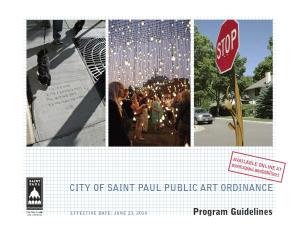
Author: City of Saint Paul Public Art
Publication Year:
Media Type: Sample document
Summary:
Saint Paul’s Public Art Ordinance arose from the aspiration and vision of civic leaders, artists and the community for a creative city at the headwaters of the Mississippi River. It arose from decades of exploration and observation as the City planned its future, as its population diversified, and as the practice of public art evolved. The Ordinance emerged in 2009 as a powerful tool that places artists at the core of civic action in shaping the form and experience of the city. The Guidelines and the supplemental Public Art Ideas List (PAIL) were first introduced by the City in September, 2012 and completed in 2013. These final Guidelines are accompanied by a Technical Manual to serve as a resource to sustain an innovative public art and design program that is distinguished by its high quality. The Technical Manual integrates the Public Art Ordinance Program into City-wide procedures and promotes contemporary best practices from the field of public art. It is designed to be used by City departments and others, and contains reference materials to support the administration of Plans and Capital Projects.
City Councilmember Russ Stark, who has represented the Council on the Oversight Committee throughout development of these Guidelines, remarks, “as we go about the incredibly important business of making Saint Paul a City that serves its citizens, attracts new residents, businesses and visitors, the Public Art Ordinance and City Artists in Residence program are playing critical roles in helping us create great places – places that reflect our history, cultures, and ideas, and that reinforce our fondness for this City and ties to our community.”
The Saint Paul Public Art Ordinance Guidelines, Technical Manual and the PAIL are available online at www.stpaul.gov/publicart
Abstract:
Saint Paul’s Public Art Ordinance arose from the aspiration and vision of civic leaders, artists and the community for a creative city at the headwaters of the Mississippi River. It arose from decades of exploration and observation as the City planned its future, as its population diversified, and as the practice of public art evolved. The Ordinance emerged in 2009 as a powerful tool that places artists at the core of civic action in shaping the form and experience of the city. The Guidelines and the supplemental Public Art Ideas List (PAIL) were first introduced by the City in September, 2012 and completed in 2013. These final Guidelines are accompanied by a Technical Manual to serve as a resource to sustain an innovative public art and design program that is distinguished by its high quality. The Technical Manual integrates the Public Art Ordinance Program into City-wide procedures and promotes contemporary best practices from the field of public art. It is designed to be used by City departments and others, and contains reference materials to support the administration of Plans and Capital Projects.
City Councilmember Russ Stark, who has represented the Council on the Oversight Committee throughout development of these Guidelines, remarks, “as we go about the incredibly important business of making Saint Paul a City that serves its citizens, attracts new residents, businesses and visitors, the Public Art Ordinance and City Artists in Residence program are playing critical roles in helping us create great places – places that reflect our history, cultures, and ideas, and that reinforce our fondness for this City and ties to our community.”
The Saint Paul Public Art Ordinance Guidelines, Technical Manual and the PAIL are available online at www.stpaul.gov/publicart
Arts & Intersections:
Categories: Public Art, Local Arts Agencies, Cultural Planning
ADDITIONAL BIBLIOGRAPHICAL INFORMATION
PUBLISHER INFORMATION
Name: City of Satnt Paul Minnesota
Website URL: https://www.stpaul.gov/